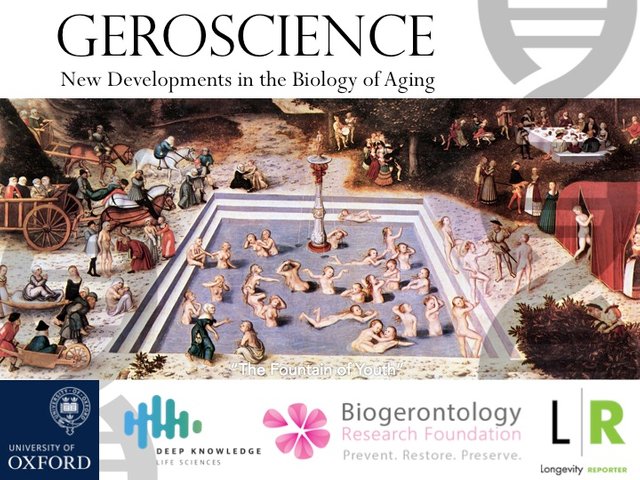
Luc7as Cranach the Elder, The Fountain of Youth 1546
This article lists recent entrants into the anti-aging biotechnology sector (including Google and J. Craig Venter); the SENS Research Foundation framework for combating aging as described by Aubrey de Grey, PhD; and recent advances in molecular biology aimed at attenuating the underlying molecular mechanisms of aging.

Challenging the “Inevitable”
Humanity has long sought an antidote to old age and death. The first documented case was the Epic of Gilgamesh (circa 2500 BC), where the fabled Mesopotamian king quested for a divine herb conferring immortality. Recent advances in biomedicine have brought the notion of attenuating aging within reach.
However you feel about biological immortality, few can argue against prolonging healthy life by slowing the rate of aging. Therefore all should applaud the high caliber shots that have been fired recently in the war on aging.

Google’s California Life Company (“Calico”)
Capturing the most media attention is Google’s new venture, California Life Company (“Calico”), which was announced in 2013. At the helm is none other than Dr. Arthur Levinson, former Genentech chairman, current chairman of Apple, and who recently resigned from the board of Roche. Calico also lured Dr. Cynthia Kenyon from UCSF in addition to several other prominent scientists like Hal V. Barron.
As of September 2014, Calico announced a partnership with AbbVie to build a Bay Area R&D center. Each party has put up $250M thus far with the option of another $500M each.
Calico has also announced a partnership with UT Southwestern Medical Center and 2M Companies to develop NAMPT activators for neurodegenerative disease.
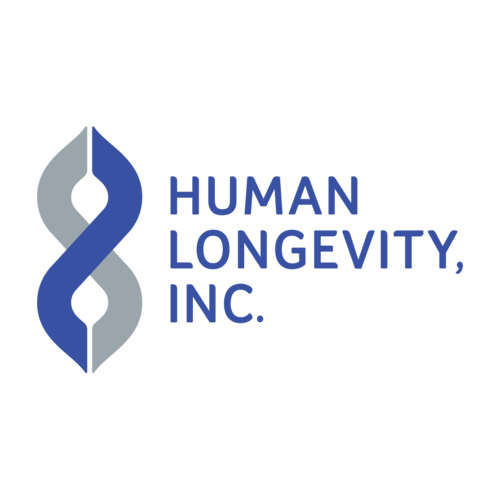
Human Longevity Inc. (“HLI”) - J. Craig Venter
Venter couldn’t keep away from the aging problem for long, and it is exciting that his resources are being channeled into the aging problem. Here is the HLI mission statement:
“Aging is the single biggest risk factor for virtually every significant human disease… our goal is to extend and enhance the healthy, high-performance lifespan and change the face of aging. For the first time, the power of human genomics, informatics, next generation DNA sequencing technologies, and stem cell advances are being harnessed in one company, Human Longevity Inc., with the leading pioneers in these fields. Our goal is to solve the diseases of aging by changing the way medicine is practiced.”
From their San Diego, CA headquarters, HLI will focus their research on human genomics, the microbiome, and stem cells. In July 2014, HLI hired Dr. Franz Och as their chief data scientist. Och is a machine learning specialist who is leaving his position as head of Google Translate.
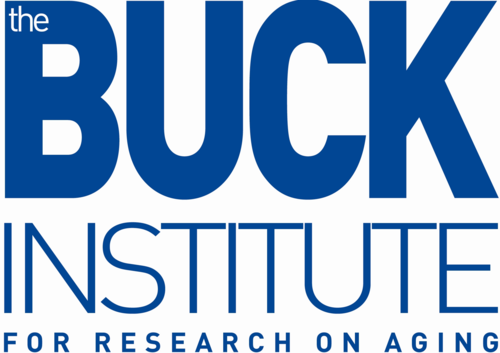
Other major efforts to understand aging take place at the Buck Institute for Research on Aging in the Bay Area and the Nathan Shock Centers of Excellence and Paul Glenn Foundation Labs at institutions around the country.
Philanthropy is an important factor for federally underfunded aging research. Once a formidable funder of aging research, Larry Ellison’s foundation has folded. Fortunately some slack is being picked up by the likes of Peter Thiel and Jason Hope.
“Ending Aging” (2007)
by Aubrey de Grey and Michael Rae
What inspired this explosion within the last two years? Are we hitting the “knee” of the exponential curve in biogerontology, now that these giants have entered the fray?
Having followed the movement for several years, one organization seems to have catalyzed this recent reaction more than any other: the SENS Research Foundation, led by Dr. Aubrey de Grey.
And one canonical text, targeted to the intelligent lay reader, encapsulates the SENS (Strategies for Engineered Negligible Senescence) research program elegantly.
The book is “Ending Aging: The Rejuvenation Breakthroughs That Could Reverse Human Aging in Our Lifetime,” co-authored by Aubrey de Grey and Michael Rae, and it remains the seminal modern treatise in biomedical gerontology.
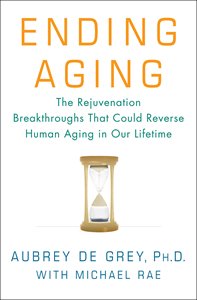
The work sets out reasons and strategies for attenuating the slow, seemingly inevitable decline in biological function that we call “aging.” The strategy doesn’t seek to tweak metabolism and uncover a silver bullet (sirtuin activators, anyone?) but rather to work around the complexity of metabolism by repairing the damage that increases with age.
The core impetus for targeting aging itself is that for the most prevalent Western diseases — heart disease, diabetes, cancer, dementia — the primary risk factor is age.
Governments and hence the private sector largely overlook this fact and do not recognize aging as a condition that can be alleviated medically. Thus little research funding flows toward what should be the focus of modern medicine, according to the authors.
The book is divided into three parts. Part I outlines why aging should be of paramount research interest. Part II explains, in terms accessible to an informed lay reader, the molecular mechanisms by which aging occur (and therapies designed to repair the damage) in Aubrey’s “Strategies for Engineered Negligible Senescence.” Part III puts forth a regulatory and research roadmap to establish a “Manhattan Project” for aging research.
—
Seven Deadly SENS
SRF has broken down the mechanisms aging into seven categories. These problems must be tackled, and proposed solutions are described in the book.
1. Cell loss and cell atrophy — Stem cells and tissue engineering
2. Nuclear (epi)mutations — WILT, short for "Whole-body Interdiction of Lengthening of Telomeres"
3. Mitochondrial mutations — Allotopic expression of 13 proteins
4. Death-resistant cells — Targeted removal
5. Extracellular crosslinks — AGE-breaking molecules and tissue engineering
6. Extracellular aggregates — Stimulating of the immune system to clear out the aggregates
7. Intracellular aggregates — Equipping the lysosome with enzymes capable of degrading the aggregates
—
Foundations of Rejuvenation
It is possible to alter cells in a petri dish such that they never stop dividing. Given the right conditions, human cells, like the notorious Henrietta Lacks “HeLa” cells, can life forever. These cells are “immortalized.” Cancer cells are often naturally immortalized by mutations of the gene encoding telomerase.
The vast majority of cells in body are replaced by stem cells regularly, from every seven days for skin cells to every seven years for bone. This rate of stem cell turnover declines with age. In light of these points, there is no apparent reason why the body could not rejuvenate itself indefinitely given the right stimuli.
It has been known since the 1930s that dietary restriction (DR) without malnutrition can dramatically slow the rate of aging, and since has been demonstrated in virtually all model organisms studied. Drugs seeking to mimic this effect are under development.
Somatic Cell Nuclear Transfer (therapeutic cloning) has been in vogue for over a decade. In 2008, cell therapy was revolutionized by a new method for generating induced pluripotent stem cells (iPSCs) from a sample of a patient’s skin. These cells could soon be sufficient to replace whole organs and potentially revitalize stem cell populations in vivo.
Recent Advances in Aging Research
This decade has witnessed the identification of genes governing aging and healthspan: insulin (daf-2, IGF-1), regulators of gene expression (FOXOs, sirtuins), and guardians of genomic stability and senescence (telomerase, HIF-1). Manipulating these genes can alter elements of the aging process and even reverse its progression. In recent years, more strategies have arisen. Just a few of the more prominent are listed below.
Heterochronic Parabiosis
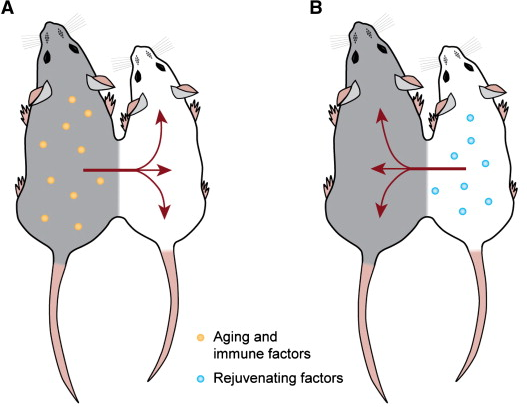
The most bizarre recent advancement has been shown with heterochronic parabiosis. This is when the circulatory systems of old and young animals are linked, sharing blood. The result: old blood ages the young mouse and young blood rejuvenates the old mouse. Cognitive, cardiac, stem cell function, and other parameters are improved in the old animal. The goal of this research is to isolate the rejuvenating factors (such as GDF-11) or remove pro-aging factors (like CCL11) as novel biologic-based therapies.
Rapamycin
Discovered on the island Rapa Nui, this natural product inhibits the activity of the nutrient sensing protein TOR (aptly named Target of Rapamycin). This activity mimics some effects of dietary restriction. Most interestingly, longevity in mice is augmented even when administered late in life. The drug has drawbacks, including increased diabetes risk. Researchers will incorporate slight modifications of the structure to preserve the good effects and cast out the bad.
PEPCK-C overexpression
The enzyme phosphoenolpyruvate carboxykinase is not normally active in skeletal muscle. When overexpressed, however, muscular endurance and longevity are augmented in mice. Compared to controls, these athletic mice are smaller, eat twice as much, and are seven times more active. In addition to longevity, reproductive capability is extended in female mice.
Senolytics: Targeting Cellular Senescence
Dr. Judith Campisi at the Buck Institute developed the paradigm of the SASP: the Senescence-Associated Secretory Phenotype. Simply put, cells that have stopped dividing and have yet to self-destruct (apoptosis) secrete inflammatory, pro-aging cytokines that alter the systemic milieu and reduce function throughout the organism.
Believed to have evolved as a check to early life cancer, cellular senescence actually leads to changes that encourage cancer and other age-related diseases. This is a possible example of antagonistic pleitropy, gene programs that improve fitness or survival early in life (pre-reproduction) become counterproductive later in old age.
The strategy is relatively straightforward: clear out senescent cells and/or suppress the SSP. Fortunately, they exhibit similar markers: staining with senescence-associated beta-galactosidase and augmented p16 expression. It has already been demonstrated that clearance of high p16-expressing cells actually reverses aging.
Causing quite a stir was a recent report showing 30% increase in median lifespan with the selective elimination of senescent cells. The company Unity Biotechnology has been spun out from the Buck to develop this line of research.
Mitoprotective agents
Mitochondrially-targeted antioxidant compounds have shown efficacy in a number of model organisms. At an optimal dose of one compound, SkQ1 (a Skulachev ion, after the Moscow State University professor who popularized the molecule), mouse health span was doubled. Additionally, senescent cells present in old mice were reduced to levels seen in the young.
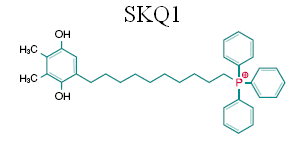
Neuropeptides
Gonadotropin-releasing hormone (GnRH), a neuropeptide released from the hypothalamus, has been shown to regulate inflammation-related aging. GnRH is classically understood as a regulator of reproduction. However, Zhang et al. showed that GnRH is negatively controlled by two inflammatory proteins, NF-kB and IKK-B. Inhibiting these proteins augmented GnRH expression, and the administration of GnRH attenuated aging-impaired neurogenesis (particularly in the hippocampus and hypothalamus).
Oxytocin plays a key role in social cognition, pair bonding, reproductive physiology, inflammation and wound healing. However, recent evidence suggests an additional role for oxytocin in muscle tissue maintenance and regeneration. It is known that the plasma concentration of oxytocin declines with age, and it has been recently shown that oxytocin knockout mice display premature sarcopenia and that systemic oxytocin administration enhances aged muscle stem cell proliferation via the MAPK/ERK signaling pathway.
Dr. Bruce Ames’ blend of acetyl-carnitine and lipoic acid
Dr. Bruce Ames, professor of biochemistry and molecular biology at UC Berkeley, has highlighted two useful rejuvenation molecules: acetyl-carnitine (ALC) and lipoic acid (LA).
At age 86, and still conducting research (he takes these two compounds, perhaps others), Ames may be the most celebrated biochemist alive. He invented the famous Ames test of mutagenicity and has won of the National Medal of Science and Thomas Hunt Morgan Medal.
A proponent of the salutary effects of natural products in foods, Ames has demonstrated that ALC and LA, alone but especially in combination, dramatically reduce mitochondrial dysfunction, cognitive decline and other measures of aging in model organisms.
Sirtuin activating compounds (STACs)
Sirtuins are NAD+ dependent histone deacetylases. That is, they remove acetyl groups from the proteins around which DNA is wrapped, regulating (typically silencing) the expression of certain genes. Sirtuins are implicated in wide range of processes impacting aging including genomic stability, apoptosis, metabolism, ROS mitigation, stress tolerance, inflammation, and chromatin organization.
Sirtuins mediate some of the benefits of dietary restriction.
When an organism is deprived of food, nicotinamide adenine dinucleotide (NAD+) levels rise relative to NADH. Higher NAD+ activates sirtuins, which silence genes at the chromatin level and deacetylate proteins involved in signaling.
In many organisms, caloric restriction without malnutrition results in prolonged lifespan, healthspan and other salutary metabolic effects (including autophagy, reduced inflammation and oxidative stress mitigation).
Sirtuin activating compounds (resveratrol, pterostilbene) may be a promising drug class. Glaxo spent over $700M to acquire Sirtis in 2007, a company led by David Sinclair at Harvard. Though this deal remains controversial, and GSK has wound down the Sirtris research, there is little doubt that STACs like pterostilbene (a more potent, lipid soluble analogue of resveratrol) offer therapeutic value with low toxicity.
Gene Therapy: The Elephant in the Room
Pharmacological interventions are the low-hanging fruit. Compounds that attenuate aging are accessible already. More will be identified using relatively hypothesis-free high throughput screening methods.
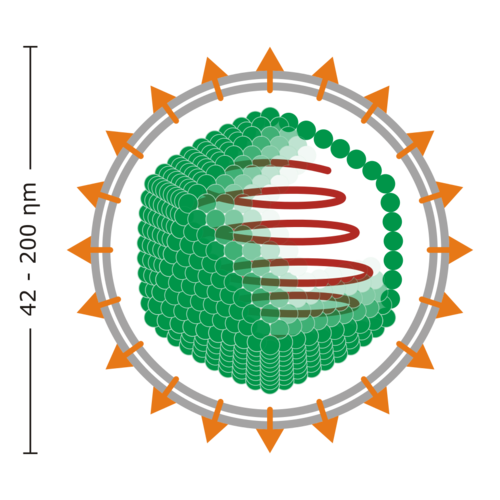
Small molecule interventions, however, will pale in comparison to gene therapy (that is, once we can get cellular delivery of fragile nucleic acids working at high efficiency).
Gene therapy has made major strides in the just last few years. The new CRISPR/Cas9 system, popularized by SRF advisor and Harvard geneticist Dr. George Church, enables unprecedented ease for genome editing.
Something of a Holy Grail, somatic (i.e., adult cells, not embryonic) genome engineering may be just around the corner. Inserting nucleic acids (DNA, RNA) into a sufficient number of adult cells has proven elusive due to the inefficiency of delivery vectors.
It is already viable to engineer induced-pluripotent stem cells in vitro, then inject after some beneficial modification (such as viral resistance in immune cells or neurotrophin secreting glial cells for neurological disorders).
Catalase, an antioxidant enzyme, when targeted to the mitochondria (which produce most cellular free radicals) also prolongs median mouse lifespan by up to 20%, in addition to attenuating parameters of cardiac and skeletal muscle aging.
One important application gene therapy is to supply telomerase to somatic tissues. Recent research has demonstrated a 24% lifespan extension in mice by this method. Most importantly, the therapy augmented health span and did not cause cancer as some believe telomerase over-expression would do in humans.
These singular interventions are just the tip of the iceberg, as combining modifications can yield synergistic effects. For example, researchers at the Buck Institute mutated the C. elegans genes for TOR and the insulin receptor, yielding a five-fold lifespan extension.
Conclusion
The government and research community must initiate a Manhattan Project to combat aging. Although it’s come a long way, biogerontology would be a much more popular sub-discipline with a proof of principle study dramatically prolonging mammalian lifespan.
The strategy proposed by de Grey and his associates is called Robust Mouse Rejuvenation. This requires that researchers begin with two year-old mice, and triple their remaining year of life (to a total of five years). The over health and functionality cannot be compromised in doing so. The Methuselah Foundation has already put up $1.4M Mouse Prize to incentive this research.
Rejuvenation biotechnology is emerging, but needs public support to make a difference. NIH funding needs to be redirected to combating aging, and researchers must not be chastised for trying to slow aging. This project promises to reduce the risk of almost all common diseases, which are age-related. Focusing on any one of them is Sisyphean.
Geroscience is about as disruptive as the internet. It will fundamentally the biopharmaceutical industry: shifting to attenuate aging and boosting organismal resilience rather than targeting a particular step or molecular entity involved in the complex cascade of a given disease. Inhibiting a cancer gene will be less effective than boosting the immune system, for example.
But if you invent teleportation, nobody will care if this year’s model of automobile has better amenities or better marketing. And the car industry will do anything to preserve the status quo. But with regard to rejuvenation biotech, I am hopeful the cat is sufficiently out of the bag already.
If successful, we will look back on the era of aging as we look back on the pre-antibiotic age: with great relief that humanity has transcended such a tragic state.
But whether and how soon this golden era arrives is up to you readers. Act as though your life depends on it – because it does.
By contributor Sebastian Aguiar - Linkedin
Further Reading:
Leading Scientists and Nobel Laureates’ Statement on Restoring Scientific Integrity to Federal Policy Making, (2004) Union of Concerned Scientists. Signatory List
Elliot, Stuart. (2008) “When Doctors, even Santa, endorsed cigarettes.” The New York Times.
Proctor, Robert N. (2012) “Golden Holocaust: Origins of the Cigarette Catastrophe and the Case for Abolition.” Harvard Magazine.
“Writings against Power & Death” (1943) by Alex Comfort, M.D, pacifist, anarchist, celebrated surgeon, prolific author, and a founder of modern gerontology
From The Longevity Reporter: The Weekly Newsletter About Aging
